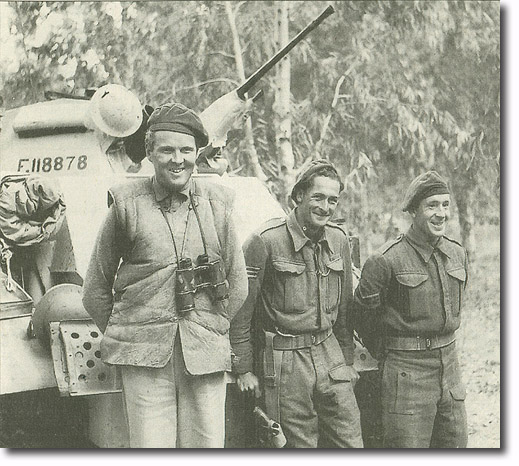|
|

 |
|
John Lawson was born on 24th October 1912 at Tadcaster, Yorkshire. His grandfather had been created a baronet in 1900 for philanthropy and services to industry. He was commissioned into the 11th Hussars in 1933 while the regiment was mechanising. Officers still kept two horses each but they were asked to reduce to one each. Later they were asked to share one between two. Lawson requested that he be given the rear part so that he wouldn't have to feed it, and he could sell the manure.
His first service overseas was in Egypt from where the regiment patrolled the border with Palestine to quell disturbances. Whilst there, Lawson excelled at cricket, tennis, polo and boxing. In 1939 he was sent on detachment to the Trans-Jordan Frontier Force. It was while on this service that he led one of the last mounted sabre charges. He was the only British officer, leading a group of Jordanians and Circassians protecting the Baghdad-Haifa oil pipeline and Jewish Colonies from attacks by Syrian tribesmen. In a valley near Beisan they came under fire and he ordered the charge. This perplexed the Syrians so much that they surrendered. For this action he was awarded the MC. After rejoining the 11th in August 1940, he fought against the Italians in the Western Desert. Later he was made commander of A Squadron and fought at El Alamein. He proved himself whilst providing officers and report centres at minefield gaps for the 22nd Armoured Brigade. He maintained communications under heavy artillery fire in which two of his three officers were killed. He passed back vital information enabling the successful engagement against the 21st Panzer Division and he penetrated German anti-tank guns to capture 11 lorries and 150 Germans. His Squadron was the first to reach Benghazi and he was awarded the DSO for his advance from El Alamein to Tripoli. Montgomery considered him to be the best Squadron Leader in the 8th Army. But this accolade worked against him in northern Europe when Montgomery ordered him to take command of the Inns of Court Armoured Car Regiment. He had just rejoined the 11th after attending Staff College and a spell in America so he expressed reluctance. Montgomery threatened to curtail his promotion prospects unless he complied. His success continued until the end of the War when he took up an Intelligence post at the War Office. Later he retired from the army and worked for his family manufacturing firm. He became Colonel of the 11th Hussars in 1965 and handled the amalgamation in 1969, with the 10th Hussars. He died in December 2001 at the age of 89. The picture shows Lawson with a sergeant and lance-corporal next to their armoured car. They wear the distinctive beret of the 11th Hussars which is khaki with a maroon head-band and no cap badge. It seems that it could be worn in a variety of ways. |
Armed Forces | Art and Culture | Articles | Biographies | Colonies | Discussion | Glossary | Home | Library | Links | Map Room | Sources and Media | Science and Technology | Search | Student Zone | Timelines | TV & Film | Wargames
